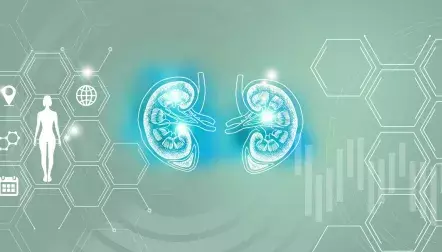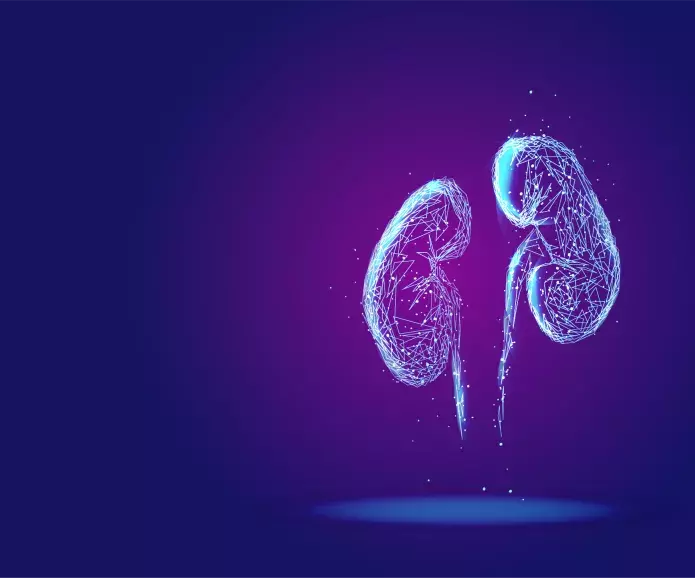
Nephrotic syndrome symptoms, causes and treatment
- Medically reviewed by
- Shahzia Lakhani
- Last updated
- June 16, 2025
What is nephrotic syndrome?
Nephrotic syndrome is a collection of symptoms that happen when there is damage to the tiny blood vessels in your kidney filters (glomeruli). This damage makes it harder for your kidneys to keep protein in your blood, and as a result, protein leaks into your urine. This can cause edema (swelling) in your body, especially in your legs, feet, ankles or face. Nephrotic syndrome can be a sign of serious kidney damage and can happen with any kidney disease that damages the filtering units, which can lead to kidney failure, also called end-stage renal disease (ESRD) or end-stage kidney disease (ESKD), if left untreated.
What are the symptoms of nephrotic syndrome?
You may not know that you have nephrotic syndrome until you have routine blood and urine tests at a doctor's appointment. Blood tests may also indicate too much or not enough protein and high levels of cholesterol (a type of fat) in your blood.
Signs of nephrotic syndrome include:
- Edema in your legs, feet, ankles (and sometimes in your face and hands)
- Weight gain
- Feeling tired
- Foamy or bubbly urine
- Decreased or low appetite
- Trouble sleeping
Talk to your doctor if you notice any combination of these symptoms.
These signs can be easy to overlook, but they may be a warning that your kidneys are not working properly.
The earlier nephrotic syndrome is diagnosed, the sooner you can begin treatment to prevent serious complications. Symptoms become more noticeable as the condition progresses.
Who is at risk for nephrotic syndrome?
Nephrotic syndrome can affect people of any age, gender or race. However, certain groups are more likely to develop the condition than others.
In children:
- Nephrotic syndrome is most often diagnosed between ages 2 and 6.
- Boys are about twice as likely as girls to develop it.
- It affects about 1 in 50,000 children each year.
- The first noticeable sign in children is often facial swelling, especially around the eyes.
In adults:
- The condition is slightly more common in men than women and is often linked to underlying health conditions.
- About 3 in 100,000 adults are diagnosed with nephrotic syndrome in the U.S. each year.
- Adults usually have edema in the legs and ankles.
You may have a higher risk of nephrotic syndrome if you:
- Have a disease that affects the kidneys, such as focal segmental glomerulosclerosis (FSGS), lupus, or diabetes
- Take certain medicines, including nonsteroidal anti-inflammatory drugs (NSAIDs) or specific antibiotics
- Have infections, such as HIV, hepatitis B or C, or malaria
In some cases, genetic testing may help identify inherited causes of nephrotic syndrome, especially in people who do not respond to treatment or have a family history of kidney disease.
What causes nephrotic syndrome?
Nephrotic syndrome occurs when different diseases damage the tiny filters in the kidneys (glomeruli). These tiny filters keep important proteins in your blood while removing waste. But when these filters are injured, too much protein leaks into your urine. Many diseases and conditions can cause nephrotic syndrome.
Kidney diseases
The most common cause of nephrotic syndrome in adults is a disease called focal segmental glomerulosclerosis (FSGS). The only way to know if you have FSGS is to get a kidney biopsy. Even with treatment, FSGS can be difficult to manage. Many people may eventually need to start dialysis or have a kidney transplant if the disease progresses. Even after having a transplant, there is still a chance that FSGS will return, and you may lose your new kidney. You should ask your doctor about new therapies that may be available to treat the underlying cause of the disease and prevent a return or worsening of the disease.
In children, the most common primary cause of nephrotic syndrome is minimal change disease.
Secondary causes
Most of the time, nephrotic syndrome happens because of secondary causes. The most common secondary cause of nephrotic syndrome in adults and children is diabetes.
What complications can it cause?
When you have nephrotic syndrome, an important protein called albumin that helps your body get rid of extra fluid, leaks into your urine instead of getting filtered by the kidneys. When you do not have enough albumin in your blood, fluid can build up in your body, causing swelling in your legs, feet, and ankles. You can also have other problems, such as blood clots and infections, such as E. coli, cellulitis (a bacterial skin infection), or peritonitis, an abdominal infectioncaused by swelling of the lining of your belly (abdomen). This happens because your body is losing antibodies in the urine, and you have a weaker immune response.
Over time, these complications can become more frequent or severe if nephrotic syndrome is not managed well. Regular follow-ups and early treatment are important to reduce long-term damage.
High cholesterol
Another complication is high cholesterol levels. When there is too much cholesterol in your blood, it can build up and form clumps in your blood vessels, increasing your risk of heart attack or stroke.
Nephrotic syndrome can also cause other serious health problems
How is nephrotic syndrome diagnosed?
Nephrotic syndrome is typically diagnosed through urine and blood tests and through a kidney biopsy.
- Urine tests. Your doctor may check your urine albumin-to-creatinine ratio (uACR), which measures how much protein is in your urine. Too much protein may mean your kidneys are not filtering properly. Protein in the urine is one of the earliest signs of nephrotic syndrome and kidney disease.
- Blood tests. Your doctor may use your blood test results to calculate your estimated glomerular filtration rate (eGFR). This number shows how well your kidneys are filtering waste from your blood. A low eGFR may be a sign of nephrotic syndrome or other kidney problems.
- Kidney biopsy. Your doctor will remove a small piece of your kidneys and look for signs of damage and disease.
Talk to your doctor and healthcare team about regular testing for your kidney function.
Questions to ask your doctor
If you find out you have nephrotic syndrome, talk with your doctor about the cause of your symptoms and what treatment is best for you. Here are some questions you may want to ask:
- What is causing my symptoms?
- Have you ruled out FSGS and other primary causes of nephrotic syndrome?
- What can I do to manage my symptoms?
- How will I know when I might need dialysis or a transplant?
- What are the chances that my nephrotic syndrome will return if I get a transplant?
- What can I do to avoid losing my new kidney to nephrotic syndrome after my transplant?
How is nephrotic syndrome treated?
There is no cure for nephrotic syndrome, but your doctor or a member of your healthcare team may recommend medicines to treat the symptoms and protect your kidney function. You might be prescribed:
- Medicine to control blood pressure and cholesterol can help prevent you from having a heart attack or a stroke.
- Medicine to help your body get rid of extra water (water pills or diuretics), which can help control your blood pressure and reduce swelling.
- Injection therapy to reduce inflammation: In some cases, medicines may be given in the form of an injection to reduce inflammation and may help to improve kidney function.
- Blood thinners may be prescribed to prevent or treat blood clots.
Regular check-ins with your care team help track your kidney function and protein levels. These visits can help your healthcare team catch problems early and update your treatment plan if needed.
Is there a special diet for nephrotic syndrome?
Changing how you eat may also help you manage your symptoms. When you have nephrotic syndrome, a dietitian may recommend that you make changes to the amount of protein, salt, and fat that you eat.

Visit Kidney Kitchen to learn more about how these nutrients can affect your kidneys.
Protein
The amount of protein you should eat depends on how healthy your kidneys are. For some people with nephrotic syndrome, eating less protein may be best. Talk to a dietitian and your nephrologist about how much protein you should eat.
Watch our webinar or download our protein guide to learn more.
Salt
Limiting how much salt (sodium) you eat and drink can help prevent swelling and keep your blood pressure at a healthy level.
Watch our video to get tips on managing sodium.
Fat
Eating foods low in saturated fat and cholesterol can help prevent high cholesterol associated with nephrotic syndrome. Choosing lean proteins like fish or low-fat cuts of meat can help control your cholesterol.

What if my kidneys fail?
If nephrotic syndrome causes your kidneys to fail, you will need dialysis or a kidney transplant. Before you know if you qualify for a kidney transplant, you must have a full health evaluation by a transplant team at a transplant center. The evaluation will help them decide if you are ready for the kidney transplant.
How long will I have to wait for a transplant
Once you have had your evaluation, the average wait time for a kidney from a deceased donor is three to five years.
If you have a donor who is willing and able to give you a kidney, you can have your transplant as soon as both you and your donor are ready. Learn more about the kidney transplant waiting list and what you can do while you wait.
Can I get nephrotic syndrome again after a transplant?
Yes, you can get nephrotic syndrome even after your transplant. Remember, nephrotic syndrome is not a single disease. It is caused by different diseases that affect your kidneys. If you get a kidney transplant but do not treat the disease that is affecting your kidneys, the disease may continue to harm your new kidney.
Where can I find more information on nephrotic syndrome?
The National Institute of Diabetes and Digestive and Kidney Diseases (NIDDK) has information about nephrotic syndrome in adults and nephrotic syndrome in children.
This educational content is made possible by ANI


